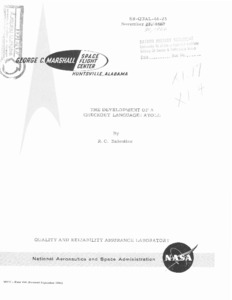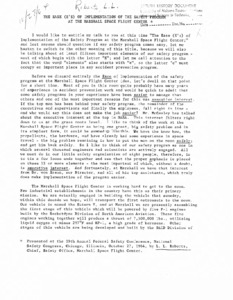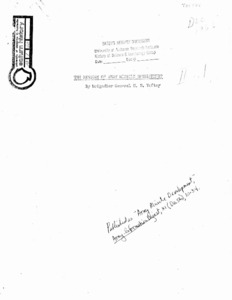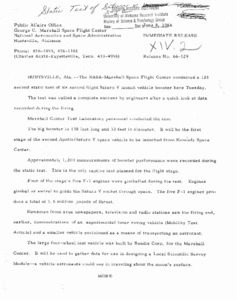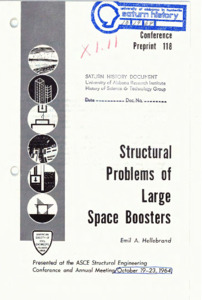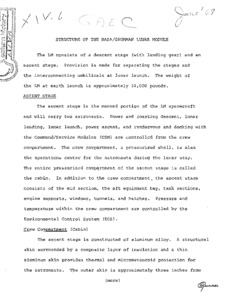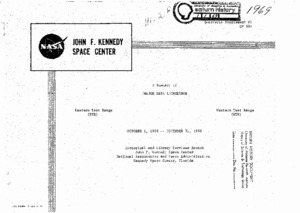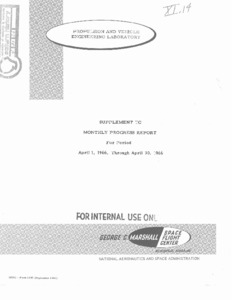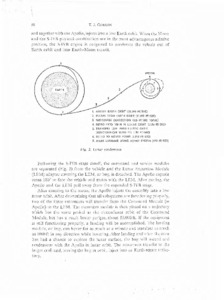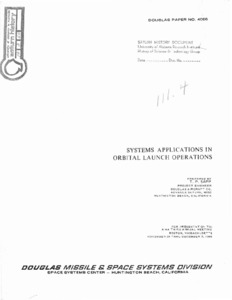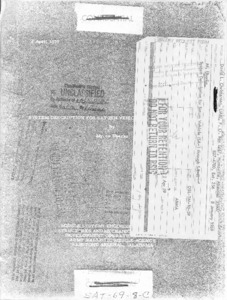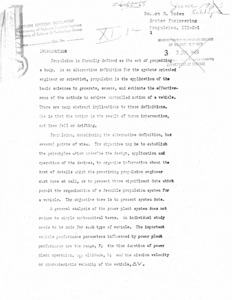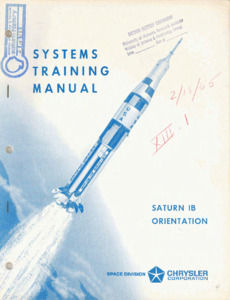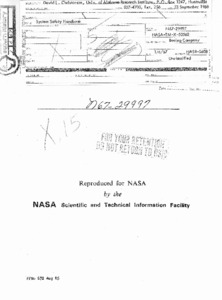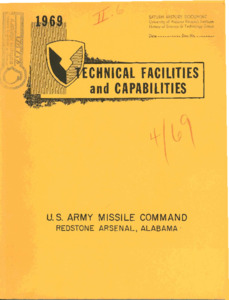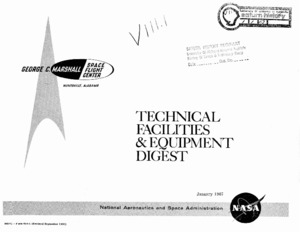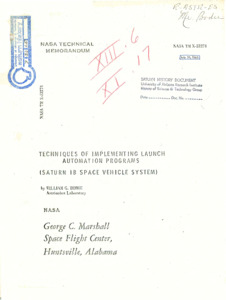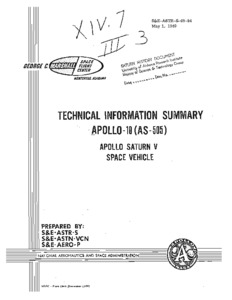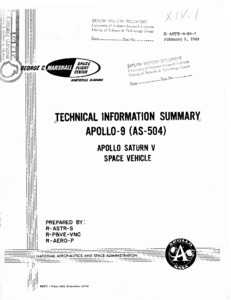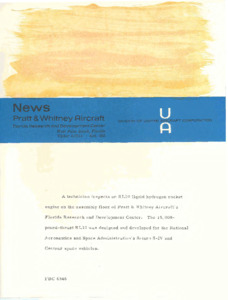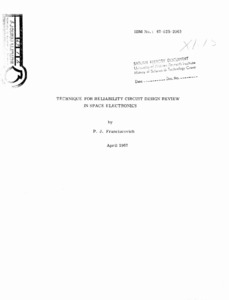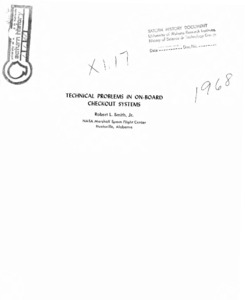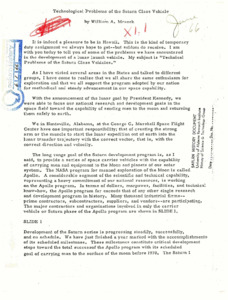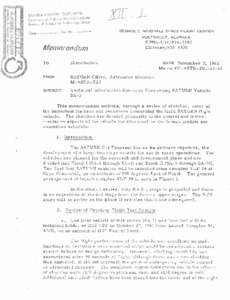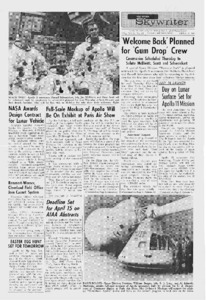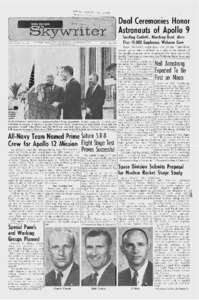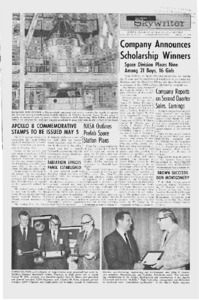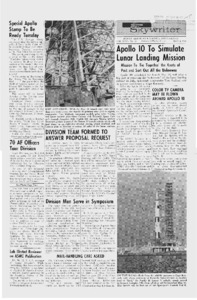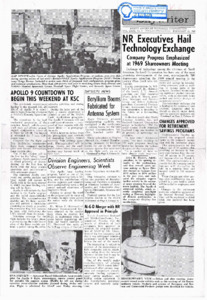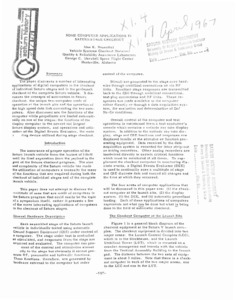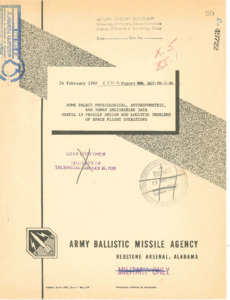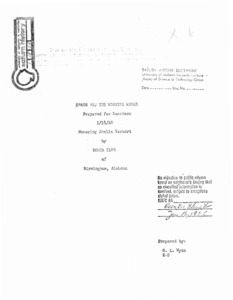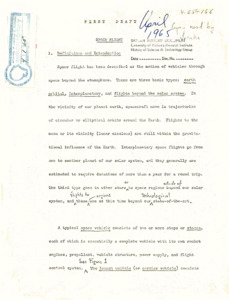
Browse Items (1965 total)
Sort by:
-
"The development of a checkout language : ATOLL."
ATOLL was developed to fulfill the requirements for a common computer language that could be used by the test engineers for launch and factory checkout. "ATOLL" is the abbreviated name for Acceptance, Test, Or Launch Language. -
"The development of a bonded common bulkhead for Saturn."
A Part of the development of the Saturn S-IV/S-IVB stage the Douglas Aircraft Company has pioneered in the development of the cryogenic common bulkhead. The term common bulkhead is derived from the design function of the bulkhead, which is to separate the two cryogenics, liquid hydrogen and liquid oxygen, in a single tank, thereby shortening the stage and eliminating the necessity for two separate bulkheads and the associated interstage structure. The common bulkhead is structurally adequate to withstand both the thermal and the pressure loads from both the hydrogen and the oxygen tanks, and it has sufficient insulation properties to prevent the liquid hydrogen from freezing the liquid oxygen. Another benefit from the common bulkhead is that it permits a reduction in the total length of the vehicle, thereby reducing the bending moments. -
"The ease (E's) of implementation of the Safety Program at the Marshall Space Flight Center."
Presented at the 19th Annual Federal Safety Conference, National Safety Congress, Chicago, Illinois. A rundown of the new safety protocols, chiefly favoring the letter 'E.' -
"The history of Army missile development."
Published as "Army Missile Development," Army Information Digest, XI. Establishes the development and history of weaponized rocket ordenance. -
"Statistical model for Saturn electrical support equipment mission availability."
This report presents the logic leading to a mathematical expression for mission availability. Mission availability is treated as the probability that the cumulative downtime occurring during a mission of given length will be less than the time constraint. This is opposed to more general approaches such as steady state or instantaneous availability or operating time versus real time. We intend to present a practical and usable mathematical model by deduction and demonstration. The development is based on exponentially distributed downtimes. Experience shows that certain systems follow exponential downtime distributions except near zero. This error is often so small that it may be neglected. A future report will present a downtime distribution which will account for this small error. -
"Static test of Saturn V S-IC : news release.
Report after second Saturn V flight test. -
"Structural problems of large space boosters."
Report discussing the flaws in having large rocket boosters. -
"Structure of the NASA/Grumman lunar module."
Describes the structure and function of each part of the NASA Lunar Module -
"A summary of major NASA launchings" between October 1st and December 31st, 1968.
This is the first Quarterly Supplement to the October 1968 edition of GP 381, ''A Summary of Major NASA Launchings (Eastern Test Range and Western Test Range)." This Supplement covers the period from October 1 to December 31, 1968. Two additional Quarterly Supplements will be issued during 1969. Each of these will list those major NASA launchings occurring during the three-month period it covers. The basic publication will be revised and reissued, incorporating the information contained in the Supplements, as well as covering the final three-month period, subsequent to October 1, 1969. William A. Lockyer, Jr. -
"Propulsion and Vehicle Engineering Laboratory monthly progress report" April.
Monthly progress report for the Propulsion Division, April 1st through April 31st -
"Propulsion and Vehicle Engineering Laboratory monthly progress report" May.
Monthly progress report for the Propulsion Division, May 1st through May 31st -
"Survey of Saturn stage test and checkout computer program development."
This survey of the Saturn Stage Test and Checkout Computer Program Development contains a summary description of the systems developed for factory and static test of the stages of the SATURN IB and SATURN V Vehicles. The responsibilities of the MSFC and stage contractor organizations that are involved in test and checkout computer program development are briefly described. The test and checkout hardware and software (computer program) systems are given for each stage and for each site where tests are conducted. The systems and procedures that are used for program production verification, documentation, and change control required for the implementation of planned computer programs are included. Notes are included in the report to indicate what material is missing or incomplete. No attempt has been made to draw any conclusions regarding the automatic test and checkout systems being developed for each stage and the manner in which the efforts are organized, scheduled, and implemented. This document has been based on material provided by stage contractors and by components of MSFC through May 1, 1966. COMPUTER SYSTEMS SECTION. VEHICLE SYSTEMS INTEGRATION BRANCH. VEHICLE SYSTEMS CHECKOUT DIVISION.; SR-QUAL-66-3. -
"A survey of propulsion problems as related to space vehicle design."
Incomplete document. Displays errors in space-vehicle design as they relate to space travel. -
"Systems applications in orbital launch operations."
The objective is to examine the technical requirements and feasibility of conducting orbital launch operations with systems now in the development phase. In order to maintain realistic constraints on the analysis, the Saturn S-IVB stage has been used as an example of present stage technology. The requirements, procedures and complexity of operations for orbital assembly and launch are discussed. The primary design requirement for orbital assembly and launch operations is increased orbital stay time (from hours to days or weeks). -
"System description for Saturn vehicle (SA-1 through SA-4)."
Missing pages iv, 3, 6 to 8. Photocopy of files containing sections of the project. -
"System engineering propulsion, III-C-1."
Page numbering is inconsistent; there are no pages numbered 14 - 17. Some pages have handwritten numbers, others have no numbers at all.; The print quality of many pages is poor. Discusses the definition and function of propulsion as well as how to most effectively employ it . -
"Saturn IB orientation training manuel."
Prepared through joint efforts of Personnel Department, Education and Development Branch, Systems Training Unit, Michoud Operations and Engineering Communications Department, Technical Information Branch, Applied Communications Engineering Section, Huntsville Operations.; This publication presents a brief descriptive summary of the Saturn IB vehicle and Chrysler's Corporation's accomplishments in the missiles and space field. The Saturn IB information presented herein is based on current plans for each of the stages. Although there may be design changes from vehicle to vehicle, the basic components, systems, and operating principles will remain similar to previous models. -
"System safety handbook."
The testing of a hardware system consists of' subjecting it to carefully controlled operating conditions for the purpose of demonstrating that this system performs its function properly. -
Technical facilities and capabilities 1969.
This brochure is being distributed to colleges and universities to acquaint and interest their students, at all acadmic levels, with the wide variety of professional and technical skills that are essential to accomplish the complex mission of the Army Missile Command, located at Redstone Arsenal, enar Huntsville, Alabama. -
"Technical facilities & equipment digest."
This document portrays the capability of technical facilities and equipment at the George C, Marshall Space Flight Center (MSFC) , one of three basic field centers under the NASA Office of Manned Space Flight. -
"Techniques of implementing launch automation programs" (Saturn IB space vehicle system).
This paper identifies the methods and equipment through which automation is becoming a major factor in testing and launching Saturn IB space vehicles. The merits of a digital guidance computer and its impact in extending automated checkout are stressed; also a logical basis is established for computer and manual test control. Hardware and software elements of the automated system are described, and details pertaining to reliability are emphasized. A concluding appraisal suggests that automation will play an expanding role in future test and launch operations. -
"Technical information summary Apollo-10 (AS-505) Apollo Saturn V space vehicle."
The document presents a brief and concise description of the AS-505 Apollo Saturn Space Vehicle. Where necessary, for clarification, additional related information has been included. -
"Technical Information Summary Apollo-9 (AS-504) Apollo Saturn V Space Vehicle."
The document presents a brief and concise description of the Apollo 9 Saturn Space Vehicle. -
"Technical information summary concerning Saturn vehicle SA-3."
This memorandum outlines, through a series of sketches, some of the important features and sequences concerning the third SATURN flight vehicle. The sketches are devoted primarily to the control and instrumentation aspects of the vehicle but also touch on the launch facility and countdown schedule. -
"Technician inspects an RL10 liquid hydrogen engine."
A technician inspects an RLlO liquid hydrogen rocket engine OD the assembly floor. of Pratt & Whitney Aircraft's Florida Research and Development Center. The 115,000-pound-thrust RLlO was designed and developed for the National Aeronautics and Space Administration's Saturn S-IV azld Centaur space vehicles. -
"Technique for reliability circuit design review in space electronics."
Design review is becoming a basic requirement during the design and development of military systems. The main purpose of the design review is to increase the system's inherent and operational reliability. The major portion of this paper is the result of reliability's effort to comply with Paragraph 3.6 of NPC 250-1 Reliability Program Provisions for Space Contractors. The design review to be discussed is a reliability circuit design review with emphasis placed on what should be reviewed and the review techniques employed. The basic circuit design review prerequisites, component parts and their ratings, are discussed at the beginning of this paper. The remainder deals with the organization and reviewing of circuits. The review items include worst-case circuit performance, component applications, failure mode analysis, noise rejection, electrical stress, and the determination of component temperatures. Many examples are included to illustrate how each item was accomplished. This paper is intended not only to give the reliability analyst cognizance of basic design problems and troublesome circuits, but also, to aid him in formulating a design review program. -
"Technical problems in on-board checkout systems."
For the purposes of this paper, an onboard checkout system is defined as a system which is built into prime flight equipment, flies with it, and permits a checkout capability to exist during all the major phases of the test and mission life of that prime equipment. Varying degrees of capability may exist in such a system, depending on what is designed into it. This, in turn, is generally dependant on life and mission requirements of the prime equipment, degree of mission checkout required, reliability restrictions,redundancy levels, data management scheme, and equally important, state of the art . Not all checkout can be accomplished with onboard equipment. Mechanical system problems such as leak detection, for example, require techniques that cannot be remotely controlled and evaluated today. On the other hand, such things as in-flight telemetry have been used for quite a long time and will continue to be used for onboard checkout. -
"Technological problems of the Saturn class vehicle."
Aerospace Workshop. University of Hawaii.; Includes references to slides. -
"Technical information summary concerning Saturn vehicle SA-3."
This memorandum outlines, through a series of sketches, some of the important features and sequences concerning the third SATURN flight vehicle. The sketches are devoted primarily to the control and instrumentation aspects of the vehicle but also touch on the launch facility and countdown schedule. -
"Welcome back planned for 'Gum Drop' crew."
A news article detailing the festivities planned upon the return of nine astronauts returning from a 10-day mission. -
"Dual ceremonies honor astronauts of Apollo 9."
A news article detailing the 'welcome back' ceremony for the nine astronauts who had just returned from a 10-day mission. -
"Company announces scholarship winners: Space Division places 9 of 21 boys and 16 girls."
A news article detailing the winners of scholarships from a competition held by Space Division. This contest was held for the children of Space Division employees. -
"Apollo 10 to simulate lunar landing mission."
A news article describing that Apollo 10's goal is to simulate a lunar landing in preparation for the real mission. -
"NR executives hail technology exchange."
A news article detailing a Technology Exchange event held by North American Rockwell Corperation. -
"Some computer applications in Saturn stage checkout."
This paper discusses a number of interesting applications of digital computers in the checkout of individual Saturn stages and in the prelaunch checkout of the complete Saturn vehicle. It discusses the concepts of automation in Saturn checkout, the unique two-computer mode of operation at the launch site and the operations of the high speed data link connecting the two computers. Also discussed are the functions of the computer while propellants are loaded automatically on one of the stages; the functions of the display computer in the newest and largest Saturn display system, and operations and utilization of the Digital Events Evaluator, the main recording device utilized during stage checkout. -
"Some select physiological, anthropometric, and human engineering data useful in vehicle design and logistic problems of space flight operations."
Report No. DSP-TM-2-60 31 p.; Pages which were blank (not scanned): 2, 26, 28 -
"Space age management or maintenance of technical capability during a period of retrenchment."
On January 3Ist of this year the United States celebrated its tenth anniversary in Space. In just one decade we have seen our space program climb from an humble beginning (a 30.8-pound payload put into orbit with a jury-rigged rocket) to extra-vehicular-activity and the tremendous Saturn V vehicle capable, of putting 250,000 pounds into low earth orbit. We have seen it grow from a "quick and dirty" operation to a program which at its peak had approximately 380,000 industrial employees in excess of {dollar}5.O billion per year. The marshalling of this great management and technological team generated many "growing pains". A few years ago the hue and cry was, "Where are we going to get sufficient people with scientific knowledge and drive to implement the space program?" Industry, sometimes reluctantly, was pressed into tasks which required managerial and technical skills beyond those they then possessed. -
"Space and the working woman."
Memorandum prepared for the honoring Amelia Earhart by the Zonta Club, Birmingham, Alabama. -
"Space flight : first draft."
Appears to be a rough dfraft with editorial comments and revision notes. Includes references to figures and tables.; Page 31 is missing. Pages 37 through 44 do not exist; there is a note about this on page 36. Page 67 also does not exist. -
"Space flight projects - today and tomorrow."
NASA symposium on scientific and technical Information.
